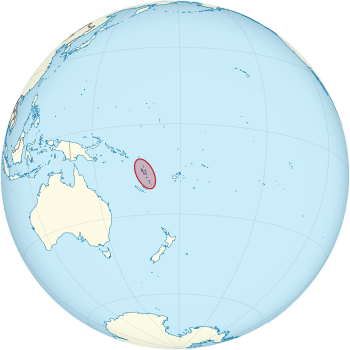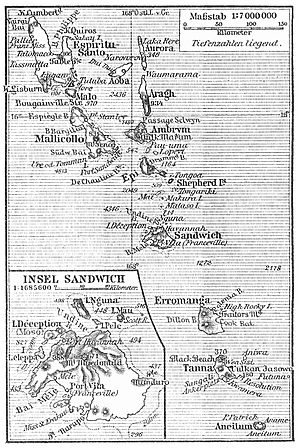New Hebrides facts for kids
Quick facts for kids
New Hebrides Condominium
Condominium des Nouvelles-Hébrides
|
|||||||||
|---|---|---|---|---|---|---|---|---|---|
| 1906–1980 | |||||||||
 |
|||||||||
| Capital | Port Vila | ||||||||
| Common languages | English, French, Bislama | ||||||||
| Government | |||||||||
| Resident Commisoner | |||||||||
| History | |||||||||
|
• Established
|
20 October 1906 | ||||||||
| 30 July 1980 | |||||||||
| Currency | New Hebrides franc, Australian dollar | ||||||||
|
|||||||||
New Hebrides was the old name for the group of islands in the South Pacific that we now call Vanuatu. Its full name was the New Hebrides Condominium. It was named after the Hebrides islands in Scotland.
People had lived on these islands for about 3,000 years before Europeans arrived. The first Europeans came in 1606 with a Spanish trip led by Pedro Fernandes de Queirós. Later, Captain James Cook named the islands in 1774. After that, both the British and the French started to settle there.
Eventually, Britain and France made a deal to share control of the islands. This special shared rule was called a condominium. It meant New Hebrides had two separate communities: one that spoke English and one that spoke French. This separation continued even after the islands became independent. Schools taught in either English or French, and there were different political groups. The condominium lasted from 1906 until 1980. In 1980, New Hebrides became an independent country called the Republic of Vanuatu.
Contents
How New Hebrides Was Governed
New Hebrides was a very unusual type of colony. Instead of one country ruling, two countries, Britain and France, shared power. This shared rule was called a Condominium.
Three Governments in One
Under the Condominium, there were three different governments working at the same time:
- One was run by the French.
- One was run by the British.
- One was a joint government, meaning both countries worked together. After 1975, some parts of this joint government were elected by the people.
The French and British governments were called "residencies." Each one had a leader called a "resident" who was chosen by their home country. These residencies were set up to be very equal. For example, if the British had an official for something, the French would have an exact match. They would often talk to each other to make decisions.
The joint government handled things that affected everyone. This included the postal service, the public radio, public works like roads, and counting the population. The two main towns, Luganville and Port Vila, also had town councils, but they didn't have much power.
Two of Everything
Early settlers were mostly British from Australia. But by the late 1800s, many more French people moved to the islands. Even though there were more French people, Britain and France decided to share power instead of one taking over.
This shared rule meant that almost everything had a duplicate. People sometimes joked and called it the "Pandemonium" instead of Condominium because of all the double systems.
- There were two police forces, each with their own rules.
- There were two health services.
- There two education systems.
- There were two different types of money (currencies).
- There were two prison systems.
Beyond these, there were separate British and French governments. This meant two different rules for who could enter the islands, two separate court systems (besides the Joint Court), and two sets of business laws. People living on the islands could even choose which government's rules they wanted to follow. This often led to disagreements between the two countries.
Laws and Courts
Local people could choose if their legal cases would be handled under English common law (British rules) or French civil law (French rules). Visitors could also choose which immigration rules to follow when they arrived.
Besides these two systems, there was a third court called the Native Court. This court handled cases that followed traditional Melanesian laws.
There was also a special Joint Court. This court had both British and French judges. For a long time, the main judge of this court was chosen by the King of Spain. But this stopped in 1939.
Since there were two court systems, there were also two prison systems. The police force was supposed to be united, but it had two chiefs and two equal groups of officers. They even wore different uniforms and took turns doing duties.
Language and Challenges
Language was a big problem for this system. All official papers had to be translated twice. First, they were translated for one side to understand, and then the reply was translated again for the other side. Luckily, a local language called Bislama helped people from both the British and French sides talk to each other.
The Condominium system was not very good for the local people, who are called Ni-Vanuatu. They were not officially citizens of any country. For example, if they wanted to travel outside the islands, they needed a special document signed by both the British and French leaders. This made many people unhappy and led to groups forming to try and gain self-rule.
World War II
During the Second World War, about 10,000 Ni-Vanuatu men joined the Vanuatu Labor Corps. This group helped the United States military during the war, especially in places like Guadalcanal. Their involvement in the war had a big impact on a local movement called the John Frum movement.
See also
 In Spanish: Nuevas Hébridas para niños
In Spanish: Nuevas Hébridas para niños
- British Empire
- French colonial empire
- List of resident commissioners of the New Hebrides
- Coconut War
- Postage stamps and postal history of Vanuatu
- History of Vanuatu





